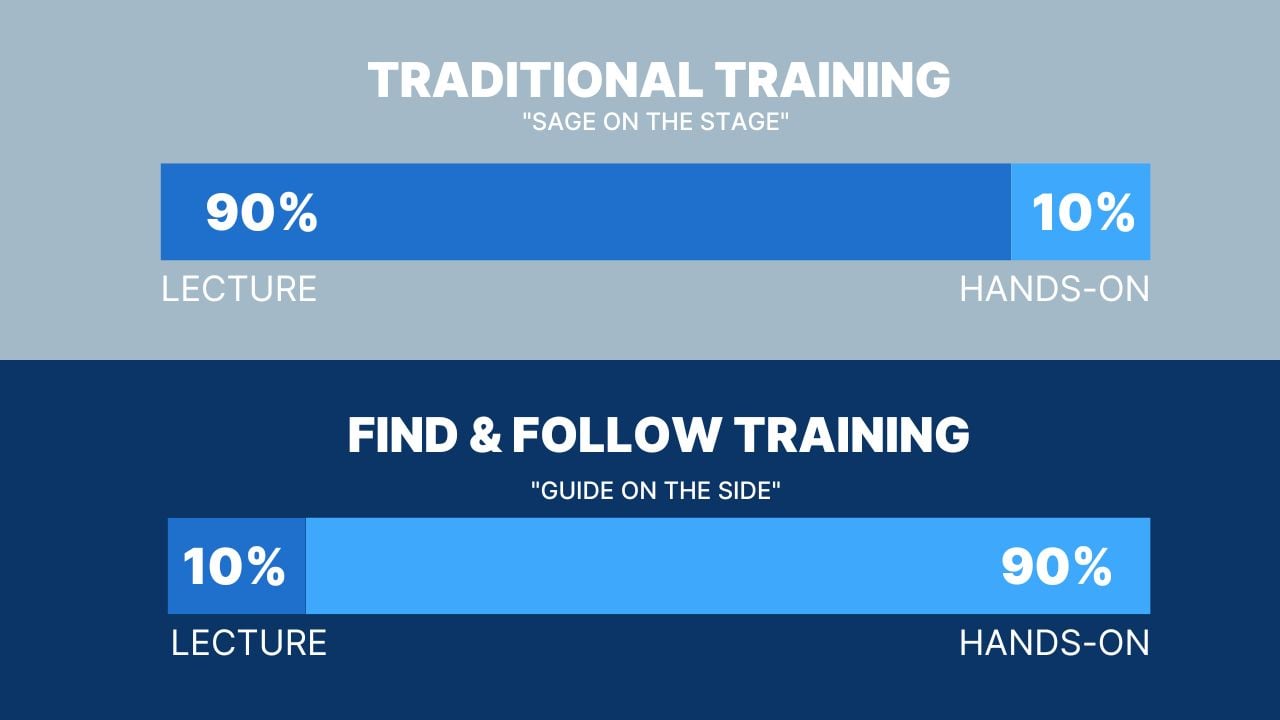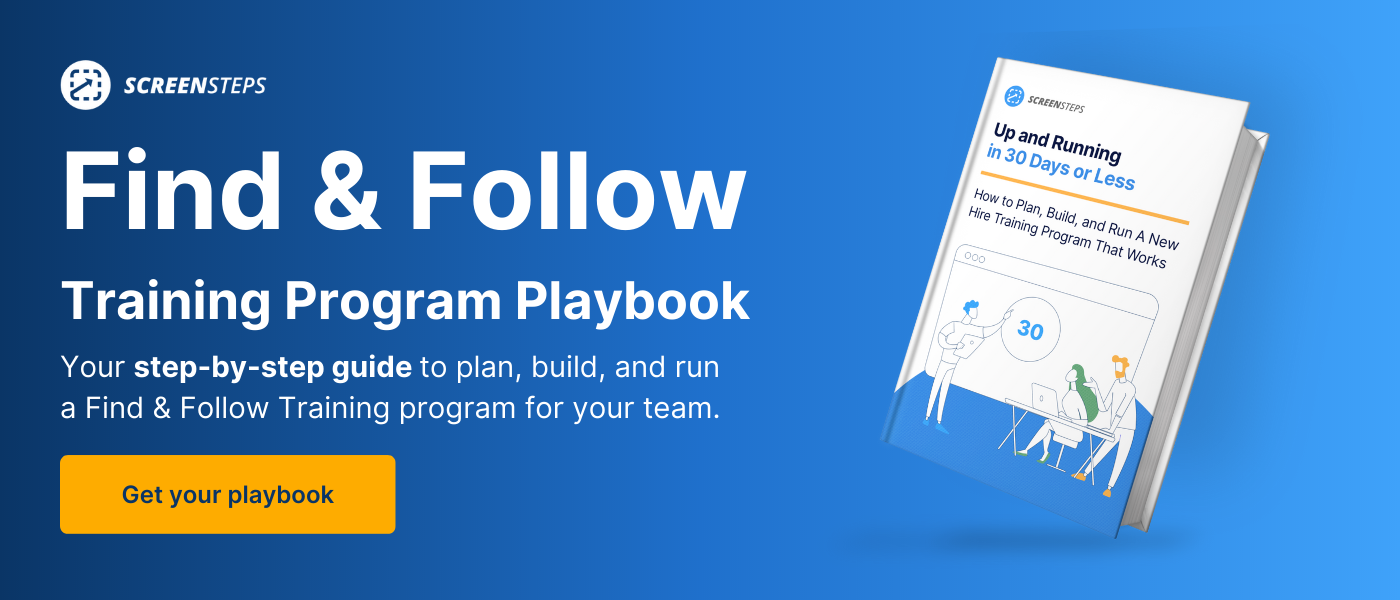What Does a Find & Follow Training Look Like?
Lecture-based training is the least effective training strategy. You’ve probably experienced this first-hand. You attend a 2-hour training and the next day, when somebody asks you what it was about, you can vaguely remember a couple of key points.
And yet, most companies still spend the majority of their time training employees with long lectures for days on end. Why? It’s because it’s what we know. Most of us had a secondary and/or college education that involved a lot of long lectures and PowerPoint presentations.
Research shows that hands-on training is the most effective way to help employees learn and retain knowledge.
That’s why ScreenSteps — a knowledge ops and knowledge management solution — developed the Find & Follow Training Framework. Find & Follow Training is centered around the fact that employees need to practice what they learn.
If you’re looking to create a training curriculum that improves employee performance and incorporates hands-on training, creating a Find & Follow Training may be the right solution for your company.
So, how do you even run a Find & Follow Training? What does it look like?
In this blog post, I’ll share how it works and what you can expect from a Find & Follow Training, including the challenges and results.
What does Find & Follow Training look like?
The way you do Find & Follow is in the name. You teach your employees how to find the guide they need and follow the instructions in the digital guides.
It sounds really simple, which it is. But, that still probably doesn’t help you envision how a training session would go down.
The easiest way to help you visualize Find & Follow Training is by comparing it to traditional training.
Traditional vs Find & Follow Training
Traditional training and Find & Follow Training use a lot of the same training approaches. It’s how the curriculum is pieced together and what approach is prioritized that sets these training strategies apart.
Traditional training
With traditional training, your trainer is a “sage on a stage.” By that I mean, the trainer is the expert who is sharing his/her wisdom and employees are listening.
This usually involves the trainer lecturing to the class for about 90% of the time and 10% of your time is spent practicing what employees have learned.
The responsibility of learning is on the shoulders of the trainer.
Find & Follow
With Find & Follow Training, those time ratios are flipped. You only spend about 10% of your training time lecturing. The other 90% of the time is spent practicing.
Instead of being a “sage on the stage,” your trainer serves as a “guide on the side.”
Find & Follow Training puts the responsibility of learning on the employees’ shoulders. They are more involved in the learning process because they are doing the work.
Check out this comparison table for a quick overview for more details on how traditional training and Find & Follow Training compare.

2-part process of Find & Follow Training
When you run a Find & Follow Training, there are two main parts to your training. You’ll repeat these two parts over and over again until your new hires can do everything they need to be able to do for their job.
1. Take a foundation course
Before I read a food recipe, it helps to know what the food is going to look like and have an overview of what the process will be like. That’s why I love recipe books with pictures of what the final dish looks like! I also enjoy watching short videos that give me a visual of the process.
The same principle applies to training. Before you have employees finding and following guides that explain how to create invoices, employees need to have some background knowledge of what invoices are, what the different products are, the kind of discounts that can be applied, and a general idea of the overall invoicing process.
That information is contained in what we call a foundational course, and that’s the first thing employees go through. These foundational courses provide a high-level overview of a topic.
Continuing with the example above, if you’re training a billing representative, one of the foundational courses a billing rep would go through is “Invoices.”
The content of that foundational course would include introducing terminology, an overview of the invoice process, the systems the invoice is processed in, the different products sold, and the other departments that might be involved in the process.
The course would include information that would help somebody follow a guide that walks through how to perform a specific task like, “How to extend the due date of an invoice.” Learners won’t need to memorize everything there is to know about invoices — they just need to be familiar with how it works.
Foundational courses are short. Ideally, they won’t last for more than 20 minutes. I recommend aiming for 10–20 minutes for your courses. If you find your courses going longer, you are either providing too many details or you need to break up your training topic into smaller categories.
A foundational course can either be given as a lecture/slide deck presentation or as a self-paced video course.
2. Participate in practice activities
After your trainees have completed the foundational course, it’s time to put what they learned to practice.
During the practice activities, you want your employees to run through procedures as if they were on the job. The practice scenarios need to be realistic.
That means they are searching your knowledge base for the right guide. Then they are following that guide as they role-play each task.
Have employees role-play different scenarios related to the foundational course. Keep in mind: You want to start with simple scenarios and build up to more complex scenarios.
For billing, those scenarios could be:
- How to process a payment
- How to resend an invoice
- How to update a billing address
- How to override a late-fee charge
I go into more detail on how to run the practice activities during a Find & Follow Training in this free on-demand webinar.
Rinse and repeat for each job
You’ll repeat this two-part training for each responsibility (or job-to-be-done) for the trainee’s role at your company.
You will cover everything the new hire needs to do for the job. That doesn’t mean you’ll cover every procedure that exists in your knowledge base, but you will cover the topic so that your employee could pull up a guide and follow it for a specific topic.
Tip: Improve employee critical thinking skills by asking them questions about the procedure. Make them look up the answer or try and figure out why something is done a certain way. That will help them begin developing expertise by recognizing patterns and connecting the dots.
The key to succeeding with Find & Follow Training
Hands-on training by itself is more effective than lecturing. But, there are simply too many procedures to memorize and too many steps and decisions in each procedure to remember.
For a Find & Follow Training to work, you need to have your procedures documented and easily accessible in your knowledge base.
Find & Follow training is impossible if you don’t have guides.
Why? As long as you have digital guides that are easy for your end-users to access, then they can pull up the guide and follow it (even if they’ve never performed that procedure before).
That’s because Find & Follow trains employees on how to find the right guide for a situation and follow that guide to handle different tasks. They don’t need to memorize every detail to handle guides without needing to ask the supervisor for help.
Your employees need to become experts at using your digital guides — not on every policy and procedure in your company.
How Find & Follow Training will change your company
Will all the effort of switching to Find & Follow Training be worth it? Yes! I wouldn’t recommend this program if we hadn’t seen dozens of companies make significant improvements in their company by switching to Find & Follow Training.
One call center saved 85% of its training budget by adopting Find & Follow. Another trained its agents 87% faster.
Some other improvements our customers have achieved with Find & Follow Training include:
- Increased performance scores
- Increased quality scores
- Decreased time to proficiency
The benefits go beyond the metrics. Find & Follow helps:
- Create self-sufficient and confident employees
- Free up supervisors’ time for other projects
- Reduced stress in the workplace
Challenges from switching to Find & Follow
Building a Find & Follow Training curriculum for your business can have a great impact on your company as stated above. But it would be unfair not to mention some of the challenges with launching a Find & Follow program in your company.
1. Initial content workload
First, it takes a lot of work upfront to get started (depending on the state of your digital guides). Since clear help guides are central to the success of your Find & Follow Organization, you need to ensure your guides can stand on their own.
You’ll also need to prepare all of your training materials (i.e. courses and a list of practice scenarios) prior to your training.
2. Cultural shift
Another challenge is that you are asking your company to go against the norm. Introducing Find & Follow at your company requires a cultural shift.
It’s important to get buy-in from everyone in your organization from the top down. You need everyone to commit to using your guides on every procedure for this to improve employee performance.
Luckily, challenges are meant to be overcome. In our free Find & Follow eBook, we show you how to plan and execute a Find & Follow Training. Or you can always hire a ScreenSteps coach to help your team prepare and launch a Find & Follow Training program.
Build a Find & Follow Training curriculum personalized for your company
Hopefully, that has helped you visualize what a Find & Follow Training will look like.
To sum it all up, Find & Follow training looks like trainees spending a lot of time with hands-on learning. New hires are able to ask trainers lots of questions as they practice using the guides and handling real on-the-job scenarios.
Ready to get started on your own Find & Follow Training curriculum?
Download our free new hire training eBook to learn how to create a Find & Follow program for your company.
If you want personalized guidance, talk to a ScreenSteps expert to figure out if Find & Follow would work in their organization.


.png)

